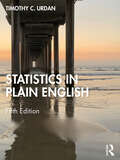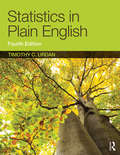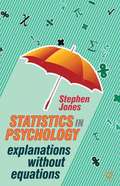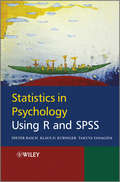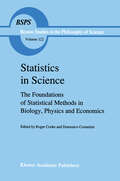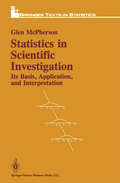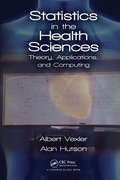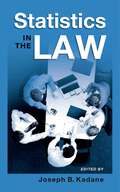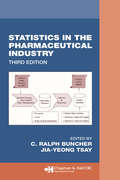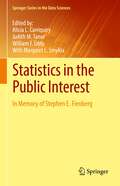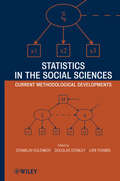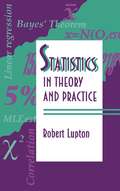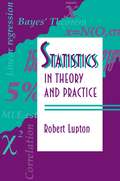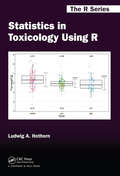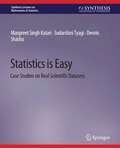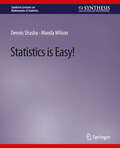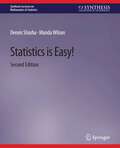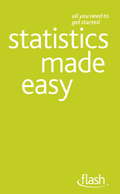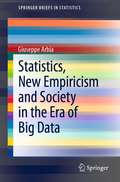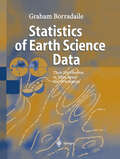- Table View
- List View
Statistics in Plain English
by Timothy C. UrdanStatistics in Plain English is a straightforward, conversational introduction to statistics that delivers exactly what its title promises. Each chapter begins with a brief overview of a statistic (or set of statistics) that describes what the statistic does and when to use it, followed by a detailed step-by-step explanation of how the statistic works and exactly what information it provides. Chapters also include an example of the statistic (or statistics) used in real-world research, "Worked Examples," "Writing It Up" sections that demonstrate how to write about each statistic, "Wrapping Up and Looking Forward" sections, and practice work problems. Thoroughly updated throughout, this edition features several key additions and changes. First, a new chapter on person-centered analyses, including cluster analysis and latent class analysis (LCA) has been added, providing an important alternative to the more commonly used variable-centered analyses (e.g., t tests, ANOVA, regression). Next, the chapter on non-parametric statistics has been enhanced with in-depth descriptions of Mann-Whitney U, Kruskal-Wallis, and Wilcoxon Signed-Rank analyses, in addition to the detailed discussion of the Chi-square statistic found in the previous edition. These nonparametric statistics are widely used when dealing with nonnormally distributed data. This edition also includes more information about the assumptions of various statistics, including a detailed explanation of the assumptions and consequences of violating the assumptions of regression, as well as more coverage of the normal distribution in statistics. Finally, the book features a multitude of real-world examples throughout to aid student understanding and provides them with a solid understanding of how several statistics techniques commonly used by researchers in the social sciences work. Statistics in Plain English is suitable for a wide range of readers, including students taking their first statistics course, professionals who want to refresh their statistical memory, and undergraduate or graduate students who need a concise companion to a more complicated text used in their class. The text works as a standalone or as a supplement and covers a range of statistical concepts from descriptive statistics to factor analysis and person-centered analyses.
Statistics in Plain English, Fourth Edition
by Timothy C. UrdanThis introductory textbook provides an inexpensive, brief overview of statistics to help readers gain a better understanding of how statistics work and how to interpret them correctly. Each chapter describes a different statistical technique, ranging from basic concepts like central tendency and describing distributions to more advanced concepts such as t tests, regression, repeated measures ANOVA, and factor analysis. Each chapter begins with a short description of the statistic and when it should be used. This is followed by a more in-depth explanation of how the statistic works. Finally, each chapter ends with an example of the statistic in use, and a sample of how the results of analyses using the statistic might be written up for publication. A glossary of statistical terms and symbols is also included. Using the author’s own data and examples from published research and the popular media, the book is a straightforward and accessible guide to statistics. New features in the fourth edition include: sets of work problems in each chapter with detailed solutions and additional problems online to help students test their understanding of the material, new "Worked Examples" to walk students through how to calculate and interpret the statistics featured in each chapter, new examples from the author’s own data and from published research and the popular media to help students see how statistics are applied and written about in professional publications, many more examples, tables, and charts to help students visualize key concepts, clarify concepts, and demonstrate how the statistics are used in the real world. a more logical flow, with correlation directly preceding regression, and a combined glossary appearing at the end of the book, a Quick Guide to Statistics, Formulas, and Degrees of Freedom at the start of the book, plainly outlining each statistic and when students should use them, greater emphasis on (and description of) effect size and confidence interval reporting, reflecting their growing importance in research across the social science disciplines an expanded website at www.routledge.com/cw/urdan with PowerPoint presentations, chapter summaries, a new test bank, interactive problems and detailed solutions to the text’s work problems, SPSS datasets for practice, links to useful tools and resources, and videos showing how to calculate statistics, how to calculate and interpret the appendices, and how to understand some of the more confusing tables of output produced by SPSS. Statistics in Plain English, Fourth Edition is an ideal guide for statistics, research methods, and/or for courses that use statistics taught at the undergraduate or graduate level, or as a reference tool for anyone interested in refreshing their memory about key statistical concepts. The research examples are from psychology, education, and other social and behavioral sciences.
Statistics in Plain English, Fourth Edition
by Timothy C. UrdanThis introductory textbook provides an inexpensive, brief overview of statistics to help readers gain a better understanding of how statistics work and how to interpret them correctly. Each chapter describes a different statistical technique, ranging from basic concepts like central tendency and describing distributions to more advanced concepts such as t tests, regression, repeated measures ANOVA, and factor analysis. Each chapter begins with a short description of the statistic and when it should be used. This is followed by a more in-depth explanation of how the statistic works. Finally, each chapter ends with an example of the statistic in use, and a sample of how the results of analyses using the statistic might be written up for publication. A glossary of statistical terms and symbols is also included. Using the author’s own data and examples from published research and the popular media, the book is a straightforward and accessible guide to statistics. New features in the fourth edition include: sets of work problems in each chapter with detailed solutions and additional problems online to help students test their understanding of the material, new "Worked Examples" to walk students through how to calculate and interpret the statistics featured in each chapter, new examples from the author’s own data and from published research and the popular media to help students see how statistics are applied and written about in professional publications, many more examples, tables, and charts to help students visualize key concepts, clarify concepts, and demonstrate how the statistics are used in the real world. a more logical flow, with correlation directly preceding regression, and a combined glossary appearing at the end of the book, a Quick Guide to Statistics, Formulas, and Degrees of Freedom at the start of the book, plainly outlining each statistic and when students should use them, greater emphasis on (and description of) effect size and confidence interval reporting, reflecting their growing importance in research across the social science disciplines an expanded website at www.routledge.com/cw/urdan with PowerPoint presentations, chapter summaries, a new test bank, interactive problems and detailed solutions to the text’s work problems, SPSS datasets for practice, links to useful tools and resources, and videos showing how to calculate statistics, how to calculate and interpret the appendices, and how to understand some of the more confusing tables of output produced by SPSS. Statistics in Plain English, Fourth Edition is an ideal guide for statistics, research methods, and/or for courses that use statistics taught at the undergraduate or graduate level, or as a reference tool for anyone interested in refreshing their memory about key statistical concepts. The research examples are from psychology, education, and other social and behavioral sciences.
Statistics In Psychology: Explanations Without Equations
by Stephen JonesA refreshing and much-needed introduction to statistics in psychology for students who 'don't get numbers'. Jones breaks from the traditional, numerical approaches, drawing on non-numerical examples and scenarios from both psychological literature and everyday life to explain key statistical concepts. This is an ideal companion to core textbooks.
Statistics in Psychology Using R and SPSS
by Dieter Rasch Klaus Kubinger Takuya YanagidaStatistics in Psychology covers all statistical methods needed in education and research in psychology. This book looks at research questions when planning data sampling, that is to design the intended study and to calculate the sample sizes in advance. In other words, no analysis applies if the minimum size is not determined in order to fulfil certain precision requirements. The book looks at the process of empirical research into the following seven stages: Formulation of the problem Stipulation of the precision requirements Selecting the statistical model for the planning and analysis The (optimal) design of the experiment or survey Performing the experiment or the survey Statistical analysis of the observed results Interpretation of the results.
Statistics in Psychology Using R and SPSS
by Dieter Rasch Klaus Kubinger Takuya YanagidaStatistics in Psychology covers all statistical methods needed in education and research in psychology. This book looks at research questions when planning data sampling, that is to design the intended study and to calculate the sample sizes in advance. In other words, no analysis applies if the minimum size is not determined in order to fulfil certain precision requirements. The book looks at the process of empirical research into the following seven stages: Formulation of the problem Stipulation of the precision requirements Selecting the statistical model for the planning and analysis The (optimal) design of the experiment or survey Performing the experiment or the survey Statistical analysis of the observed results Interpretation of the results.
Statistics in Science: The Foundations of Statistical Methods in Biology, Physics and Economics (Boston Studies in the Philosophy and History of Science #122)
by DomenicoCostantini RogerCookeAn inference may be defined as a passage of thought according to some method. In the theory of knowledge it is customary to distinguish deductive and non-deductive inferences. Deductive inferences are truth preserving, that is, the truth of the premises is preserved in the con clusion. As a result, the conclusion of a deductive inference is already 'contained' in the premises, although we may not know this fact until the inference is performed. Standard examples of deductive inferences are taken from logic and mathematics. Non-deductive inferences need not preserve truth, that is, 'thought may pass' from true premises to false conclusions. Such inferences can be expansive, or, ampliative in the sense that the performances of such inferences actually increases our putative knowledge. Standard non-deductive inferences do not really exist, but one may think of elementary inductive inferences in which conclusions regarding the future are drawn from knowledge of the past. Since the body of scientific knowledge is increasing, it is obvious that the method of science must allow non-deductive as well as deductive inferences. Indeed, the explosive growth of science in recent times points to a prominent role for the former. Philosophers of science have long tried to isolate and study the non-deductive inferences in science. The inevitability of such inferences one the one hand, juxtaposed with the poverty of all efforts to identify them, constitutes one of the major cognitive embarrassments of our time.
Statistics in Scientific Investigation: Its Basis, Application, and Interpretation (Springer Texts in Statistics)
by Glen McPhersonIn this book I have taken on the challenge of providing an insight into Statistics and a blueprint for statistical application for a wide audience. For students in the sciences and related professional areas and for researchers who may need to apply Statistics in the course of scientific experimenta tion, the development emphasizes the manner in which Statistics fits into the framework of the scientific method. Mathematics students will find a unified, but non-mathematical structure for Statistics which can provide the motivation for the theoretical development found in standard texts on theoretical Statistics. For statisticians and students of Statistics, the ideas contained in the book and their manner of development may aid in the de velopment of better communications between scientists and statisticians. The demands made of readers are twofold: a minimal mathematical prerequisite which is simply an ability to comprehend formulae containing mathematical variables, such as those derived from a high school course in algebra or the equivalent; a grasp of the process of scientific modeling which comes with ei ther experience in scientific experimentation or practice with solving mathematical problems.
Statistics in the Health Sciences: Theory, Applications, and Computing (Chapman & Hall/CRC Biostatistics Series)
by Albert Vexler Alan Hutson"This very informative book introduces classical and novel statistical methods that can be used by theoretical and applied biostatisticians to develop efficient solutions for real-world problems encountered in clinical trials and epidemiological studies. The authors provide a detailed discussion of methodological and applied issues in parametric, semi-parametric and nonparametric approaches, including computationally extensive data-driven techniques, such as empirical likelihood, sequential procedures, and bootstrap methods. Many of these techniques are implemented using popular software such as R and SAS."— Vlad Dragalin, Professor, Johnson and Johnson, Spring House, PA "It is always a pleasure to come across a new book that covers nearly all facets of a branch of science one thought was so broad, so diverse, and so dynamic that no single book could possibly hope to capture all of the fundamentals as well as directions of the field. The topics within the book’s purview—fundamentals of measure-theoretic probability; parametric and non-parametric statistical inference; central limit theorems; basics of martingale theory; Monte Carlo methods; sequential analysis; sequential change-point detection—are all covered with inspiring clarity and precision. The authors are also very thorough and avail themselves of the most recent scholarship. They provide a detailed account of the state of the art, and bring together results that were previously scattered across disparate disciplines. This makes the book more than just a textbook: it is a panoramic companion to the field of Biostatistics. The book is self-contained, and the concise but careful exposition of material makes it accessible to a wide audience. This is appealing to graduate students interested in getting into the field, and also to professors looking to design a course on the subject." — Aleksey S. Polunchenko, Department of Mathematical Sciences, State University of New York at Binghamton This book should be appropriate for use both as a text and as a reference. This book delivers a "ready-to-go" well-structured product to be employed in developing advanced courses. In this book the readers can find classical and new theoretical methods, open problems and new procedures. The book presents biostatistical results that are novel to the current set of books on the market and results that are even new with respect to the modern scientific literature. Several of these results can be found only in this book.
Statistics in the Health Sciences: Theory, Applications, and Computing (Chapman & Hall/CRC Biostatistics Series)
by Albert Vexler Alan Hutson"This very informative book introduces classical and novel statistical methods that can be used by theoretical and applied biostatisticians to develop efficient solutions for real-world problems encountered in clinical trials and epidemiological studies. The authors provide a detailed discussion of methodological and applied issues in parametric, semi-parametric and nonparametric approaches, including computationally extensive data-driven techniques, such as empirical likelihood, sequential procedures, and bootstrap methods. Many of these techniques are implemented using popular software such as R and SAS."— Vlad Dragalin, Professor, Johnson and Johnson, Spring House, PA "It is always a pleasure to come across a new book that covers nearly all facets of a branch of science one thought was so broad, so diverse, and so dynamic that no single book could possibly hope to capture all of the fundamentals as well as directions of the field. The topics within the book’s purview—fundamentals of measure-theoretic probability; parametric and non-parametric statistical inference; central limit theorems; basics of martingale theory; Monte Carlo methods; sequential analysis; sequential change-point detection—are all covered with inspiring clarity and precision. The authors are also very thorough and avail themselves of the most recent scholarship. They provide a detailed account of the state of the art, and bring together results that were previously scattered across disparate disciplines. This makes the book more than just a textbook: it is a panoramic companion to the field of Biostatistics. The book is self-contained, and the concise but careful exposition of material makes it accessible to a wide audience. This is appealing to graduate students interested in getting into the field, and also to professors looking to design a course on the subject." — Aleksey S. Polunchenko, Department of Mathematical Sciences, State University of New York at Binghamton This book should be appropriate for use both as a text and as a reference. This book delivers a "ready-to-go" well-structured product to be employed in developing advanced courses. In this book the readers can find classical and new theoretical methods, open problems and new procedures. The book presents biostatistical results that are novel to the current set of books on the market and results that are even new with respect to the modern scientific literature. Several of these results can be found only in this book.
Statistics in the Law: A Practitioner's Guide, Cases, and Materials
by Joseph B. KadaneStatistics in the Law is primarily a user's manual or desk reference for the expert witness-lawyer team and, secondarily, a textbook or supplemental textbook for upper level undergraduate statistics students. It starts with two articles by masters of the trade, Paul Meier and Franklin Fisher. It then explains the distinction between the Frye and Daughbert standards for expert testimony, and how these standards play out in court. The bulk of the book addresses individual cases covering a wide variety of questions, including: ·Does electronic draw poker require skill to play? ·Did the New Jersey State Police disproportionately stop black motorists? ·Is a jury a representative cross section of the community? ·Were ballots tampered with in an election? The book concludes with Part 5, a review of English law, that includes a case in which a woman was accused of murdering her infant sons because both died of "cot death" or "sudden death syndrome," (she was convicted, but later exonerated), and an examination of how Bayesian analyses can (or more precisely), cannot be presented in UK courts. In each study, the statistical analysis is shaped to address the relevant legal questions, and draws on whatever methods in statistics might shed light on those questions.
Statistics In the Pharmaceutical Industry (Chapman & Hall/CRC Biostatistics Series)
by C. Ralph Buncher Jia-Yeong TsayThe growth of the pharmaceutical industry over the past decade is astounding, but the impact of this growth on statistics is somewhat confusing. While software has made analysis easier and more efficient, regulatory bodies now demand deeper and more complex analyses, and pharmacogenetic/genomic studies serve up an entirely new set of challenges. For more than two decades, Statistics in the Pharmaceutical Industry has been the definitive guide to sorting through the challenges in the industry, and this Third Edition continues that tradition. Updated and expanded to reflect the most recent trends and developments in the field, Statistics in the Pharmaceutical Industry, Third Edition presents chapters written by experts from both regulatory agencies and pharmaceutical companies who discuss everything from experimental design to post-marketing studies. This approach sheds light on what regulators consider acceptable methodologies and what methods have proven successful for industrial statisticians. Both new and revised chapters reflect the increasingly global nature of the industry as represented by authors from Japan and Europe, the increasing trend toward non-inferiority/equivalence testing, adaptive design in clinical trials, global harmonization of regulatory standards, and multiple comparison studies. The book also examines the latest considerations in anti-cancer studies. Statistics in the Pharmaceutical Industry, Third Edition demystifies the approval process by combining regulatory and industrial points of view, making it a must-read for anyone performing statistical analysis at any point in the drug approval process.
Statistics in the Public Interest: In Memory of Stephen E. Fienberg (Springer Series in the Data Sciences)
by Alicia L. Carriquiry Judith M. Tanur William F. EddyThis edited volume surveys a variety of topics in statistics and the social sciences in memory of the late Stephen Fienberg. The book collects submissions from a wide range of contemporary authors to explore the fields in which Fienberg made significant contributions, including contingency tables and log-linear models, privacy and confidentiality, forensics and the law, the decennial census and other surveys, the National Academies, Bayesian theory and methods, causal inference and causes of effects, mixed membership models, and computing and machine learning. Each section begins with an overview of Fienberg’s contributions and continues with chapters by Fienberg’s students, colleagues, and collaborators exploring recent advances and the current state of research on the topic. In addition, this volume includes a biographical introduction as well as a memorial concluding chapter comprised of entries from Stephen and Joyce Fienberg’s close friends, former students, colleagues, and other loved ones, as well as a photographic tribute.
Statistics in the Social Sciences: Current Methodological Developments
by Stanislav Kolenikov Lori Thombs Douglas SteinleyA one-of-a-kind compilation of modern statistical methods designed to support and advance research across the social sciences Statistics in the Social Sciences: Current Methodological Developments presents new and exciting statistical methodologies to help advance research and data analysis across the many disciplines in the social sciences. Quantitative methods in various subfields, from psychology to economics, are under demand for constant development and refinement. This volume features invited overview papers, as well as original research presented at the Sixth Annual Winemiller Conference: Methodological Developments of Statistics in the Social Sciences, an international meeting that focused on fostering collaboration among mathematical statisticians and social science researchers. The book provides an accessible and insightful look at modern approaches to identifying and describing current, effective methodologies that ultimately add value to various fields of social science research. With contributions from leading international experts on the topic, the book features in-depth coverage of modern quantitative social sciences topics, including: Correlation Structures Structural Equation Models and Recent Extensions Order-Constrained Proximity Matrix Representations Multi-objective and Multi-dimensional Scaling Differences in Bayesian and Non-Bayesian Inference Bootstrap Test of Shape Invariance across Distributions Statistical Software for the Social Sciences Statistics in the Social Sciences: Current Methodological Developments is an excellent supplement for graduate courses on social science statistics in both statistics departments and quantitative social sciences programs. It is also a valuable reference for researchers and practitioners in the fields of psychology, sociology, economics, and market research.
Statistics in Theory and Practice
by Robert LuptonAimed at a diverse scientific audience, including physicists, astronomers, chemists, geologists, and economists, this book explains the theory underlying the classical statistical methods. Its level is between introductory "how to" texts and intimidating mathematical monographs. A reader without previous exposure to statistics will finish the book with a sound working knowledge of statistical methods, while a reader already familiar with the standard tests will come away with an understanding of their strengths, weaknesses, and domains of applicability. The mathematical level is that of an advanced undergraduate; for example, matrices and Fourier analysis are used where appropriate. Among the topics covered are common probability distributions; sampling and the distribution of sampling statistics; confidence intervals, hypothesis testing, and the theory of tests; estimation (including maximum likelihood); goodness of fit (including c2 and Kolmogorov-Smirnov tests); and non-parametric and rank tests. There are nearly one hundred problems (with answers) designed to bring out points in the text and to cover topics slightly outside the main line of development.
Statistics in Theory and Practice
by Robert LuptonAimed at a diverse scientific audience, including physicists, astronomers, chemists, geologists, and economists, this book explains the theory underlying the classical statistical methods. Its level is between introductory "how to" texts and intimidating mathematical monographs. A reader without previous exposure to statistics will finish the book with a sound working knowledge of statistical methods, while a reader already familiar with the standard tests will come away with an understanding of their strengths, weaknesses, and domains of applicability. The mathematical level is that of an advanced undergraduate; for example, matrices and Fourier analysis are used where appropriate. Among the topics covered are common probability distributions; sampling and the distribution of sampling statistics; confidence intervals, hypothesis testing, and the theory of tests; estimation (including maximum likelihood); goodness of fit (including c2 and Kolmogorov-Smirnov tests); and non-parametric and rank tests. There are nearly one hundred problems (with answers) designed to bring out points in the text and to cover topics slightly outside the main line of development.
Statistics in Toxicology Using R
by Ludwig A. HothornThe apparent contradiction between statistical significance and biological relevance has diminished the value of statistical methods as a whole in toxicology. Moreover, recommendations for statistical analysis are imprecise in most toxicological guidelines. Addressing these dilemmas, Statistics in Toxicology Using R explains the statistical analysi
Statistics in Toxicology Using R (Chapman And Hall/crc The R Ser.)
by Ludwig A. HothornThe apparent contradiction between statistical significance and biological relevance has diminished the value of statistical methods as a whole in toxicology. Moreover, recommendations for statistical analysis are imprecise in most toxicological guidelines. Addressing these dilemmas, Statistics in Toxicology Using R explains the statistical analysi
Statistics is Easy: Case Studies on Real Scientific Datasets (Synthesis Lectures on Mathematics & Statistics)
by Manpreet Singh Katari Sudarshini Tyagi Dennis ShashaComputational analysis of natural science experiments often confronts noisy data due to natural variability in environment or measurement. Drawing conclusions in the face of such noise entails a statistical analysis. Parametric statistical methods assume that the data is a sample from a population that can be characterized by a specific distribution (e.g., a normal distribution). When the assumption is true, parametric approaches can lead to high confidence predictions. However, in many cases particular distribution assumptions do not hold. In that case, assuming a distribution may yield false conclusions. The companion book Statistics is Easy, gave a (nearly) equation-free introduction to nonparametric (i.e., no distribution assumption) statistical methods. The present book applies data preparation, machine learning, and nonparametric statistics to three quite different life science datasets. We provide the code as applied to each dataset in both R and Python 3. We also include exercises for self-study or classroom use.
Statistics is Easy! (Synthesis Lectures on Mathematics & Statistics)
by Dennis Shasha Manda WilsonStatistics is the activity of inferring results about a population given a sample. Historically, statistics books assume an underlying distribution to the data (typically, the normal distribution) and derive results under that assumption. Unfortunately, in real life, one cannot normally be sure of the underlying distribution. For that reason, this book presents a distribution-independent approach to statistics based on a simple computational counting idea called resampling. This book explains the basic concepts of resampling, then systematically presents the standard statistical measures along with programs (in the language Python) to calculate them using resampling, and finally illustrates the use of the measures and programs in a case study. The text uses junior high school algebra and many examples to explain the concepts. The ideal reader has mastered at least elementary mathematics, likes to think procedurally, and is comfortable with computers. Table of Contents: The Basic Idea / Bias Corrected Confidence Intervals / Pragmatic Considerations When Using Resampling / Terminology / The Essential Stats / Case Study: New Mexico's 2004 Presidential Ballots / References
Statistics is Easy! 2nd Edition (Synthesis Lectures on Mathematics & Statistics)
by Dennis Shasha Manda WilsonStatistics is the activity of inferring results about a population given a sample. Historically, statistics books assume an underlying distribution to the data (typically, the normal distribution) and derive results under that assumption. Unfortunately, in real life, one cannot normally be sure of the underlying distribution. For that reason, this book presents a distribution-independent approach to statistics based on a simple computational counting idea called resampling. This book explains the basic concepts of resampling, then system atically presents the standard statistical measures along with programs (in the language Python) to calculate them using resampling, and finally illustrates the use of the measures and programs in a case study. The text uses junior high school algebra and many examples to explain the concepts. Th e ideal reader has mastered at least elementary mathematics, likes to think procedurally, and is comfortable with computers. Table of Contents: The Basic Idea / Pragmatic Considerations when Using Resampling / Terminology / The Essential Stats / Case Study: New Mexico's 2004 Presidential Ballots / References / Bias Corrected Confidence Intervals / Appendix B
Statistics Made Easy: Statistics Made Easy (Flash)
by Alan GrahamThe books in this bite-sized new series contain no complicated techniques or tricky materials, making them ideal for the busy, the time-pressured or the merely curious. Statistics Made Easy is a short, simple and to-the-point guide to statistics. In just 96 pages, the reader will learn all about why we do the things we do. Ideal for the busy, the time-pressured or the merely curious, Statistics Made Easy is a quick, no-effort way to break into this fascinating topic.
Statistics - Misleading Diagrams (tactile)
by RnibThis diagram shows 2 graphs illustrating misleading diagrams in statistics. The x-axis' show the date and the y-axis' show %. There is a note saying to read the page sideways and there is a key at the top of the page.
Statistics, New Empiricism and Society in the Era of Big Data (SpringerBriefs in Statistics)
by Giuseppe ArbiaThis book reveals the myriad aspects of Big Data collection and analysis, by defining and clarifying the meaning of Big Data and its unique characteristics in a non-technical and easy-to-follow way. Moreover, it discusses critical issues and problems related to the Big Data revolution and their implications for both Statistics as a discipline and for our everyday lives. The author identifies various problems and limitations in the quantitative analysis of Big Data, with regard to e.g. its volume, velocity and variety, as well as its reliability and veridicity. Dedicated chapters focus on the epistemological aspects of data-based knowledge and ethical aspects of the use of Big Data, while also addressing paradigmatic cases such as Cambridge Analytica and the use of data from social networks to influence election outcomes.
Statistics of Earth Science Data: Their Distribution in Time, Space and Orientation
by Graham J. BorradaileFrom the reviews: "All in all, Graham Borradaile has written and interesting and idiosyncratic book on statistics for geoscientists that will be welcome among students, researchers, and practitioners dealing with orientation data. That should include engineering geologists who work with things like rock fracture orientation measurements or clast alignment in paleoseismic trenches. It won’t replace the collection of statistics and geostatistics texts in my library, but it will have a place among them and will likely be one of several references to which I turn when working with orientation data.... The text is easy to follow and illustrations are generally clear and easy to read..."(William C. Haneberg, Haneberg Geoscience)
